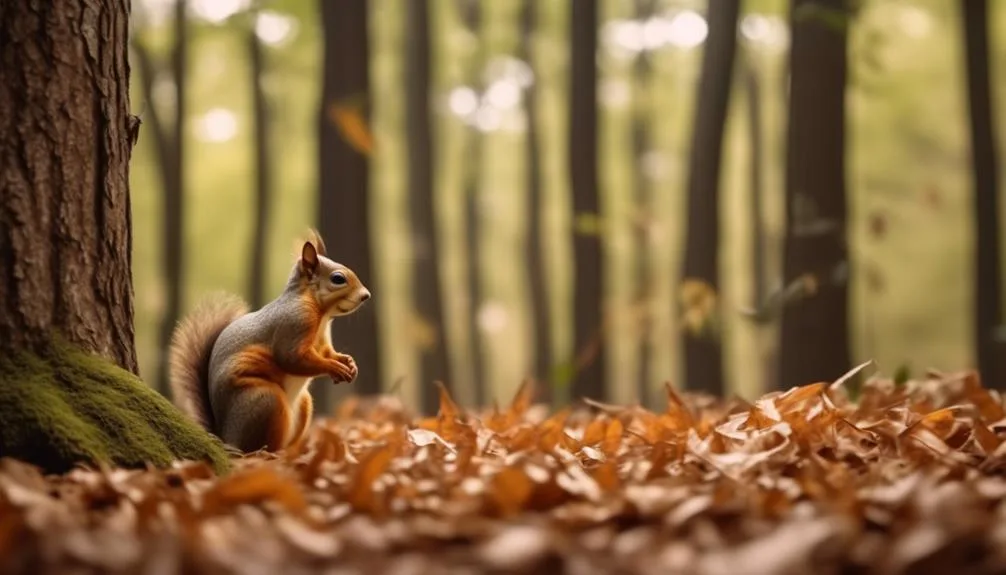Hickory trees serve as a vital source of food and shelter for a diverse range of wildlife. Their nuts and sturdy branches provide essential sustenance for countless species. However, their significance extends beyond mere survival.
The intricate connections that hickory trees have with the natural world reveal a multitude of reasons why wildlife relies on these majestic trees. Their role in supporting and sustaining various forms of wildlife is truly remarkable.
Nutritious Food Source
Hickory trees provide a highly nutritious food source for various wildlife, including squirrels, deer, and birds, offering a rich supply of energy and essential nutrients. The nuts of the hickory tree are a vital component of wildlife diet diversity, enriching the foraging opportunities for animals in woodland habitats.
These nutrient-rich nuts are packed with proteins, healthy fats, and carbohydrates, which are essential for the survival and well-being of many species. Squirrels rely heavily on hickory nuts as a primary food source, while deer and birds also benefit from the abundance of nutrition provided by these trees.
This diet diversity supports the health and vitality of the wildlife population, contributing to the overall balance and sustainability of the ecosystem. Hickory trees play a crucial role in ensuring that wildlife have access to vital nutrients for their survival.
Shelter and Nesting Sites
Nestled among the sturdy branches and dense foliage of hickory trees, various wildlife species find secure shelter and ideal nesting sites, fostering a thriving ecosystem within the woodland habitat.
Here's why hickory trees are important for providing shelter and nesting sites for wildlife:
- Wildlife Habitat: Hickory trees offer a diverse range of shelter options for wildlife, including tree cavities that serve as safe havens for nesting, roosting, and raising young.
- Ecological Balance: These trees play a crucial role in maintaining the ecological balance by providing nesting sites for various bird species, such as woodpeckers, owls, and nuthatches.
- Protection: The sturdy branches and dense foliage of hickory trees offer protection from predators and the elements, creating a safe environment for nesting and sheltering wildlife.
- Biodiversity: By providing secure nesting sites, hickory trees contribute to the overall biodiversity and health of the woodland ecosystem.
Supporting Biodiversity
Supporting a rich tapestry of life, hickory trees play a vital role in fostering biodiversity within their woodland habitat. These trees are crucial for maintaining ecological balance and supporting diverse wildlife habitats.
Hickory trees provide food, shelter, and nesting sites for a wide range of species, from birds and mammals to insects and fungi. Their nuts are a vital food source for many animals, contributing to ecosystem stability and food web relations.
The complex structure of hickory forests creates niches for various species, promoting biodiversity and strengthening the overall health of the ecosystem. In this way, hickory trees contribute to the interconnected web of life, ensuring the survival of numerous plant and animal species and enhancing the resilience of the natural environment.
Seed Dispersal
Nourishing a diverse array of species, hickory trees play a critical role in the dispersal of their seeds, ensuring the continuation of their genetic legacy and contributing to the ecological balance of their woodland habitat. This process is crucial for forest ecology, and it involves a fascinating interplay of animal behavior.
Here's how it happens:
- Animal Foraging: Squirrels and other rodents gather hickory nuts for food, often burying them for later consumption.
- Seed Storage: These animals frequently forget some of the buried nuts, effectively planting them in different locations.
- Long-Distance Transport: Birds also aid in seed dispersal by carrying hickory nuts away from the parent tree.
- Germination: Once dispersed, the hickory seeds have the opportunity to germinate in new areas, contributing to the tree's distribution and genetic diversity.
Importance for Endangered Species
Hickory trees play a vital role in supporting endangered species through their provision of food and habitat, contributing to the preservation of biodiversity in their ecosystem.
The dense foliage and sturdy branches of hickory trees provide safe nesting sites for endangered bird species such as the Cerulean Warbler and the Red-headed Woodpecker.
Additionally, the nuts produced by hickory trees are a crucial food source for various endangered mammals, including the Indiana bat and the Allegheny woodrat.
By offering a suitable habitat and a reliable food source, hickory trees aid in habitat preservation and conservation efforts for these vulnerable species.
Moreover, the presence of hickory trees helps maintain ecological balance and sustains food chain dynamics, essential for the survival of endangered species within their natural environments.
Conclusion
In the intricate tapestry of the forest, hickory trees stand as vital guardians, providing sustenance and sanctuary for a diverse array of wildlife. Their presence not only supports biodiversity but also safeguards the delicate balance of ecosystems.
Without hickory trees, the very fabric of nature would be irrevocably altered, leaving countless species at risk. Their significance resonates far beyond their towering forms, underscoring the interconnectedness of all life in the natural world.
Mark Hoffman is a dedicated arborist and tree care specialist with over a decade of experience. His love for trees began when he visited Yosemite National Park as a teenager and was awestruck by the giant sequoias. Mark pursued his passion by studying forestry at Michigan Technological University, where he earned a Bachelor of Science degree.
Since then, he has worked tirelessly in the field of arboriculture, helping to preserve and protect trees in his community. His expertise and dedication have made him a respected leader in the industry and a valuable resource for anyone seeking advice on tree care.
